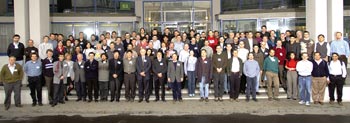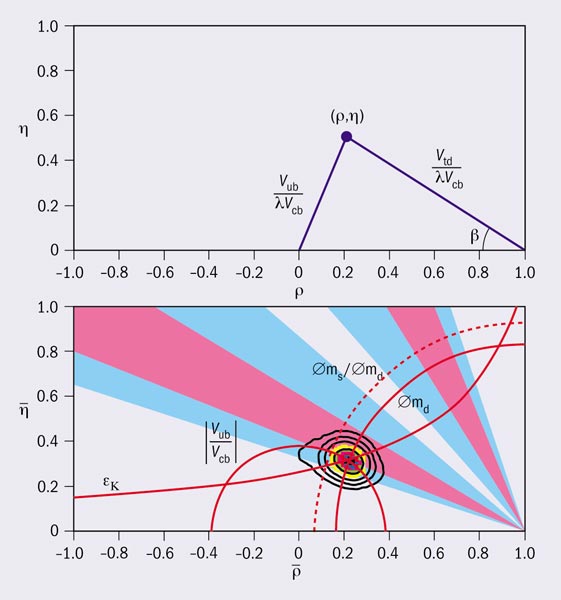In 1963, Nicola Cabibbo proposed a mechanism to describe transformations between up, down and strange quarks. Almost a decade later, Makoto Kobayashi and Toshihide Maskawa generalized quark mixing to six quarks. At a recent workshop hosted by CERN, more than 200 researchers took stock of how far experiment has come in unravelling the mixing matrix.
Quark mixing is a topic that has attracted intense scrutiny ever since it was first proposed in the 1960s. Recently, CERN’s Large Electron-Positron collider (LEP) has made important measurements concerning mixing, particularly hadrons containing b quarks (see LEP helps fill CKM matrix). Properties such as B hadron lifetimes, the oscillations between particles and antiparticles for neutral B mesons, and the couplings of the b quark to the other quark flavours were all studied at LEP, and the results have had a significant impact on our understanding of quark mixing.
The LEP experiments were the first to observe the time dependence of oscillations of the neutral B0 meson and measure its oscillation frequency precisely. However, the data used for most of these B physics analyses were taken a number of years ago. The LEP detectors have now been dismantled and the collaborations are reaching the end of their studies. The more complex analyses (for example, the search for high-frequency oscillations of neutral strange quark-containing B0s mesons) have just been completed. Meanwhile, the B-factories at SLAC in California, US, and KEK in Japan (see CP violation enters a new era) are dedicated to studying this physics and are producing enormous samples of B mesons. In particular, they have recently demonstrated CP violation in the B0 meson system. Experiments at the upgraded Tevatron at Fermilab in Chicago, US, also have a rich B physics programme and are starting to take data.

To mark this transition, a workshop on the subject of quark mixing was held at CERN in February. Its aim was to review the current status of theory and experiment and to provide an opportunity for the fruitful exchange of ideas between the theoretical and experimental communities. The meeting’s title – workshop on the CKM unitarity triangle – refers to the Cabibbo-Kobayashi-Maskawa (CKM) matrix that describes quark mixing in the Standard Model.
The concept of quark mixing was first developed by Cabibbo, who introduced a single mixing angle to describe transitions between up, down and strange quarks. With the discovery of the charm quark, this was extended to a matrix describing mixing between quarks of the first two generations. Kobayashi and Maskawa then generalized mixing for six quark flavours, described by the three-by-three CKM matrix. This gives the couplings Vij between the up-type quarks i = u,c,t and the down-type quarks j = d,s,b. The matrix should be unitary (a weakly decaying quark should transform into one of the other known quark flavours) and this unitarity condition leads to relationships between the elements of the matrix. The nine complex matrix elements can be described by four parameters – three mixing angles and a phase (one mixing angle and no phase would be required if there were only four quark flavours). The introduction of a phase is crucial, as Kobayashi and Maskawa recognized. That it allows for CP violation – matter-antimatter asymmetry – in the Standard Model led them to propose that mixing occurs between three generations of quarks – long before the members of the last generation (b and t) were discovered.
The unitarity triangle
A widely used parameterization of the quark mixing matrix which was developed by Lincoln Wolfenstein of Carnegie Mellon University, US, expresses the elements as an expansion in the powers of λ – the sine of the Cabibbo angle – which has a known value of 0.22 from kaon and hyperon decays. The remaining three parameters required to describe the mixing are denoted as A, ρ and η. In this parameterization, the element Vcb is given by Aλ2 and has been well measured from the semileptonic decays of hadrons containing the b quark, leading to a value for A of 0.84. The values of the two parameters ρ and η remain to be determined.
One of the unitarity conditions of the CKM matrix is VudV*ub + VcdV*cb + VtdV*tb = 0. Dividing by VcdV*cb leads to a triangular relationship in the ρ, η plane, where the length of the base is unity. The left-hand side of the triangle is proportional to Vub/Vcb, which can be measured by studying semileptonic B meson decays into charmless final states, and the right-hand side is proportional to Vtd/Vcb, which can be extracted from the B0 oscillation frequency.

This triangle is known as the unitarity triangle, and it neatly summarizes the state of knowledge of this physics. The angles of its sides correspond to the phases of the matrix elements involved, and are directly related to the CP asymmetries that are predicted to occur in B decays. In particular, the time-dependent asymmetry between the decays of B0 and anti-B0 mesons to a J/ψ and a Ks is expected to have the form sin2ΒsinΔmdt, where Δmd is the B0 oscillation frequency and Β is the angle between the right-hand side of the triangle and its base (twice the phase of B0 mixing). This is the channel that the B-factories have used to observe CP violation in the B0 system. Many other decay modes (including those for B0s mesons) can be used to measure different CP asymmetries, and thus determine the other angles of the triangle. However, that programme of measurements lies in the future, in particular at the dedicated B physics experiments at hadron colliders – LHCb at CERN’s LHC, and BTeV at Fermilab’s Tevatron.
First workshop
The workshop at CERN was intended to be the first of two meetings and concentrated on measurements of the sides of the triangle using existing data. The second workshop will cast an eye towards future B physics to be carried out at the LHC. The meeting was organized by Achille Stocchi and Marco Battaglia from the DELPHI experiment at LEP, who have played an important role in the working groups that were set up by the LEP collaborations to supervise the combination of their results.
The work of these groups has been widely appreciated and their data have been used by rapporteurs at conferences and featured in the Particle Data Group (PDG) review of particle properties. They have expanded to provide world averages including representatives from the SLD experiment at SLAC, CLEO at Cornell, and Fermilab’s CDF. One of the aims of the workshop was to discuss how the work of these LEP-based groups should be taken over by representatives of the experiments that are now leading the field, in particular the B-factories. Weiming Yao from the PDG chaired a dedicated session on this issue, with discussion involving representatives from all of the experiments in a very constructive atmosphere. The B-factory experiments, BaBar at SLAC and Belle at KEK, expressed their commitment to taking the lead in future B physics averaging.
Relating measured quantities to the CKM matrix elements involves understanding how the quarks are bound into hadrons, since the couplings refer to quarks but the observed particles are hadrons. This is the realm of QCD, but in the non-perturbative regime in which an exact solution is not possible. A key theoretical framework in the field of unitarity triangle studies is lattice QCD, in which the equations can be solved by discretizing space-time onto a network of points. The accuracy of the predictions is then limited by the computing power available, which limits the size of the lattice and the spacing of its points; in the limit of zero lattice spacing the exact solution of QCD would be recovered. In addition, to save on computing resources, the pair production of light quarks from the vacuum (the so-called quenched approximation has usually been neglected). Lattice QCD has the attraction that most of the theoretical parameters required for unitarity triangle studies have been calculated in a consistent framework. Some first results are becoming available without quenching using two light quark flavours. These can be used to estimate the effect of the quenched approximation, which appears to be encouragingly small for most variables studied. Discussion started at the workshop on creating a “lattice data group” with representatives from the numerous groups pursuing lattice QCD. This would aim to provide a consensus on the best use of lattice results, combining them where relevant along the lines of the PDG for experimental results.

The workshop was based around three working groups, the first of which concentrated on the left-hand side of the triangle and the second on the right-hand side. The third working group studied the thorny issue of how all the various measurements that are relevant to the unitarity triangle should best be combined. Converting the measured quantities into constraints on ρ and η is only possible with the guidance of theory, with corresponding uncertainties. How best to deal with theoretical errors has proved controversial in the past, because they do not generally follow the Gaussian distribution that straightforward error combination relies on.
There are two main schools of thought concerning the fit for the apex of the triangle – those following Bayesian statistics and those following Frequentist statistics. It was a major success of the workshop to bring proponents of these two approaches together and compare in detail the results when their fitting programs are applied to the same inputs. The main difference is that when an input parameter has a quoted statistical (Gaussian) component to its uncertainty and a systematic component that is taken to be flat between certain limits, the Bayesian approach convolutes the two errors, whereas the Frequentist approach corresponds to adding them linearly, giving a more conservative result. If the two fitting programs are fed with the same input likelihoods, the allowed regions that result are very similar. The issue therefore becomes not one of which statistical school to believe, but rather of how to ensure that the theoretical uncertainties are correctly handled. The latest result of the unitarity triangle fit from the group using the Bayesian approach – performed during the workshop itself using all the agreed inputs from the other working groups – is shown in figure 1. This fit gives an indirect measurement of the angle Β, corresponding to sin2Β lying within the range 0.57-0.81 at 95% confidence level. It is in excellent agreement with the direct measurement from the B-factories, which is indicated by the coloured bands.
The workshop was very well attended, with more than 200 participants and a strong international mix of delegates. The four days of meetings involved lively discussion, with sessions running late into the evening, and the summary session took place on a Saturday morning. The success of this first meeting has led to the proposal for the next meeting to be held by the Institute of Particle Physics Phenomenology in Durham, UK, in conjunction with the next in their series of workshops on heavy-flavour physics and CP violation. The second meeting will therefore take place in either Durham or the nearby Lake District next spring.





